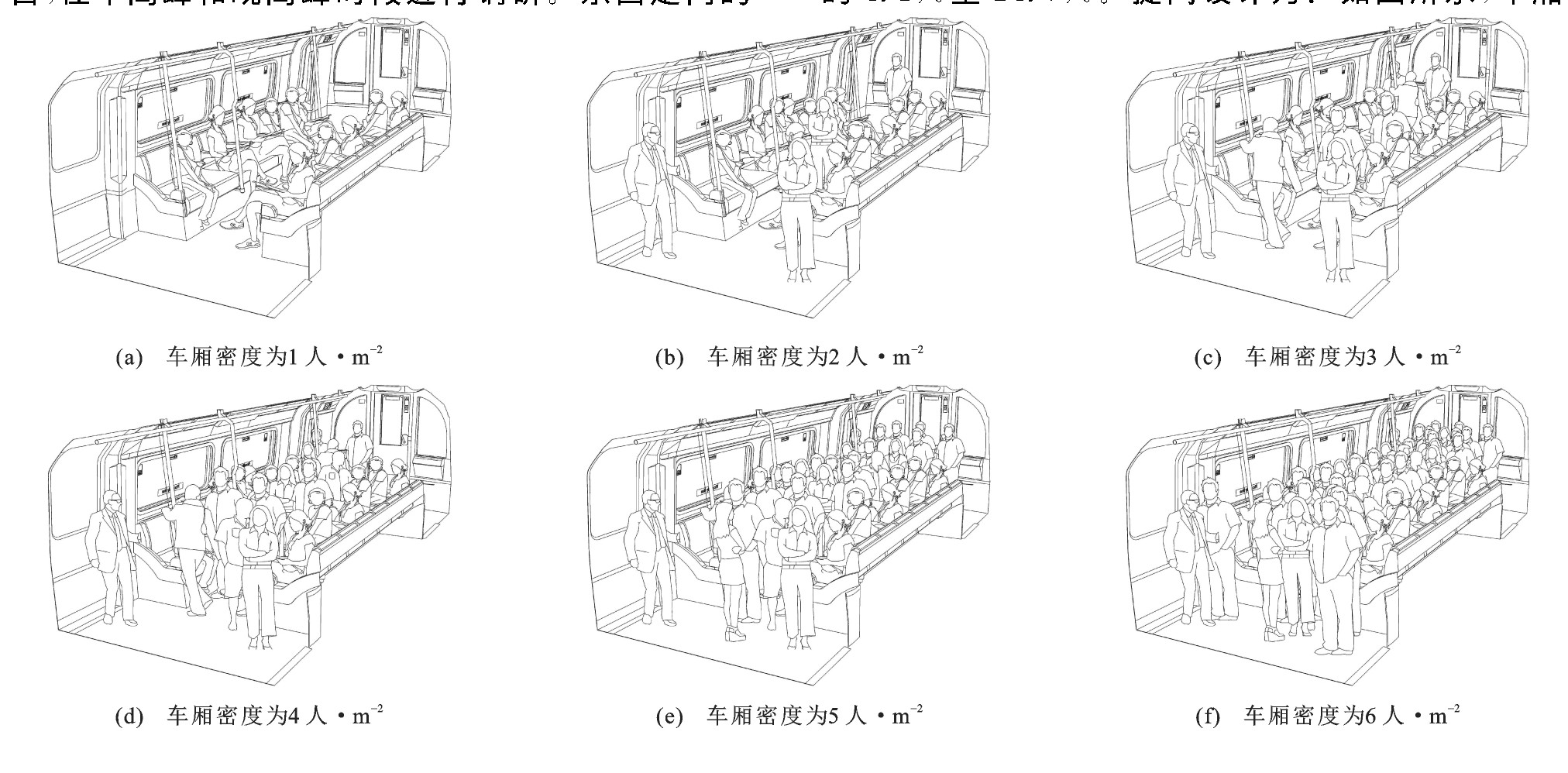Estimation method of crowding cost in urban rail transit carriages
-
摘要: 应用离散决策分析法与条件价值法, 设计了双边界二分式调研问卷, 计算了考虑拥挤度的轨道交通出行总成本;通过延长车厢内乘客出行时间的方式来换取车厢内乘客密度的减少, 从而得到车厢内不同拥挤度下的等价出行效能;通过调研得到乘客对两轮投标的选择概率;分别采用双变量Probit估计量和随机效用估计量来推断时间边际负效用的标准化值, 得到时间乘数, 进而估计乘客的延时意愿和支付意愿;基于2015~2016年北京地铁1号线和5号线具有代表性的15个车站站台调查获得的数据, 对轨道交通车厢内6种拥挤度下的时间乘数进行线性回归分析。研究结果表明:车厢内的乘客密度和时间乘数存在线性关系, 而改善后的车厢内拥挤度和广义成本呈反比例关系;出行者支付意愿随车厢拥挤度的减少而增加, 当车厢拥挤度由5人·m-2改善为4人·m-2时, 早、晚高峰时段的支付意愿分别为1.58元和3.02元, 当车厢拥挤度由5人·m-2改善为3.5人·m-2时, 早、晚高峰时段的支付意愿分别为2.47元和4.99元, 因此, 晚高峰时段出行者的平均支付意愿达到早高峰时段的2倍左右, 不同时段出行者对改善拥挤度的支付意愿存在显著差异。Abstract: The discrete choice analysis and contingent valuation method were used to design a double-bounded dichotomous questionnaire to calculate the total generalized cost of rail transit, including the crowding degrees.The passenger densities in the carriage was reduced by extending the travel time of passengers in the carriage, and the equivalent travel efficiencies were obtained under different crowding degrees in the carriage.The passengers' choice probability for two rounds of bidding was obtained from the questionnaire feedback.The bivariate probit estimators and random utility estimators were used to deduce the standardized value of the time marginal disutility, and then the time multiplier was obtained to estimate the passengers' willingness to travel longer and the willingness to pay.Based on the data obtained from the survey of 15 representative platforms of Beijing Metro Lines 1and 5in 2015-2016, a linear regression analysis was made for the time multiplier under six crowding degrees in the rail transit carriage.Analysis result shows that there is a linear relationship between the passenger density in the carriage and the time multiplier, but an inverse proportion between the crowding degrees after improvementand the generalized cost in the carriage.Traveler's willingness to pay increases with the reduction of crowding degree in the carriage.When the crowding degree improves from 5 person·m-2 to 4 person·m-2, the willingness to pay for peak hours in the morning and evening is RMB 1.58 and 3.02, respectively.When the crowding degree improves from 5 person·m-2 to 3.5 person·m-2, the willingness to pay for peak hours in the morning and evening increase to RMB 2.47 and 4.99, respectively.Therefore, traveler's average payment willingness in the evening peak is approximate twice that in the morning peak, and there are significant differences in the payment willingness for the improved crowding degree at different periods.
-
表 1 北京地铁出行特征调研统计结果
Table 1. Survey statistical result of travel characteristics of Beijing metro

表 2 预期密度比例
Table 2. Expected density proporations

表 3 密度指标
Table 3. Density indicators

表 4 对假设场景投标认可度统计
Table 4. Statistics of acceptance rates to bidding on hypothetical scenarios

表 5 不同拥挤度下出行时间边际负效用的估计值与标准误差
Table 5. Estimators and standard errors of marginal disutility of travel time under different crowding degrees

表 6 随机效用模型时间乘数估计值
Table 6. Time multiplier estimators of random utility model

表 7 方差分析结果
Table 7. Results of variance analysis

表 8 回归模型系数
Table 8. Coefficients of regression model

表 9 车厢内出行时间与机会成本调查数据
Table 9. Survey data of in-vehicle travel time and opportunity cost

表 10 0 时间乘数
Table 10. Time multipliers

表 11 1 密度改善后的延时意愿、支付意愿和公交总成本
Table 11. Delay willingness, payment willingness and total bus costs after density improvement

-
[1] OLIO D L, IBEAS A, CECI'N P. Modelling user perception of bus transit quality[J]. Transport Policy, 2010, 17 (6): 388-397. doi: 10.1016/j.tranpol.2010.04.006 [2] 《公共交通补贴对缓解交通压力的实证研究》项目组. 我国城市公共交通补贴政策分析——以北京市为例[J]. 中国集体经济, 2013 (6): 42-45. doi: 10.3969/j.issn.1008-1283.2013.06.020“Empirical Study of Public Transport Subsidies on Relieving Traffic Stress”Project Group. Analysis of urban public transport subsidies policy in China: a case study of Beijing[J]. China Collective Economy, 2013 (6): 42-45. (in Chinese). doi: 10.3969/j.issn.1008-1283.2013.06.020 [3] NESHELI M M, CEDER A. Improved reliability of public transportation using real-time transfer synchronization[J]. Transportation Research Part C: Emerging Technologies, 2015, 60: 525-539. doi: 10.1016/j.trc.2015.10.006 [4] 史芮嘉, 毛保华, 丁勇, 等. 地铁车厢内乘客站立位置选择行为研究[J]. 交通运输系统工程与信息, 2017, 17 (2): 142-147, 159. https://www.cnki.com.cn/Article/CJFDTOTAL-YSXT201702021.htmSHI Rui-jia, MAO Bao-hua, DING Yong, et al. Pedestrian choice behavior analysis of standing position in subway carriage[J]. Journal of Transportation Systems Engineering and Information Technology, 2017, 17 (2): 142-147, 159. (in Chinese). https://www.cnki.com.cn/Article/CJFDTOTAL-YSXT201702021.htm [5] TIRACHINI A, HENSHER D A, ROSE J M. Crowding in public transport systems: effects on users, operation and implications for the estimation of demand[J]. Transportation Research Part A: Policy and Practice, 2013, 53: 36-52. doi: 10.1016/j.tra.2013.06.005 [6] 席亚军, 林建辉, 苏燕辰, 等. 地铁车厢火灾蔓延规律及人员疏散安全性研究[J]. 铁道科学与工程学报, 2017, 14 (3): 619-625. doi: 10.3969/j.issn.1672-7029.2017.03.024XI Ya-jun, LIN Jian-hui, SU Yan-chen, et al. Subway car fire spreading rules and evacuation safety studies[J]. Journal of Railway Science and Engineering, 2017, 14 (3): 619-625. (in Chinese). doi: 10.3969/j.issn.1672-7029.2017.03.024 [7] 王瑞山, 靳澜涛. 地铁场所踩踏事故的生成特征与风险治理——2008年以来15起典型事故的考察[J]. 中国人民公安大学学报: 社会科学版, 2016 (4): 141-148. https://www.cnki.com.cn/Article/CJFDTOTAL-GADX201604020.htmWANG Rui-shan, JIN Lan-tao. Generating characteristics and risk management of trampling accidents in metro places: an investigation of 15typical accidents since 2008[J]. Journal of People's Public Security University of China: Social Science Edition, 2016 (4): 141-148. (in Chinese). https://www.cnki.com.cn/Article/CJFDTOTAL-GADX201604020.htm [8] PEL A J, BEL N H, PIETERS M. Including passengers'response to crowding in the Dutch national train passenger assignment model[J]. Transportation Research Part A: Policy and Practice, 2014, 66: 111-126. doi: 10.1016/j.tra.2014.05.007 [9] TIRACHINI A, HENSHER D A. Bus congestion, optimal infrastructure investment and the choice of a fare collection system in dedicated bus corridors[J]. Transportation Research Part B: Methodological, 2011, 45 (5): 828-844. doi: 10.1016/j.trb.2011.02.006 [10] 蒋盛川, 孙轶凡, 杜豫川. 拥挤度对公共交通方式选择意愿的影响[J]. 同济大学学报: 自然科学版, 2012, 40 (12): 1831-1835JIANG Sheng-chuan, SUN Yi-fan, DU Yu-chuan. Influence of in-vehicle congestion degree on choice of public transit mode[J]. Journal of Tongji University: Natural Science, 2012, 40 (12): 1831-1835. https://www.cnki.com.cn/Article/CJFDTOTAL-TJDZ201212016.htm(in Chinese). https://www.cnki.com.cn/Article/CJFDTOTAL-TJDZ201212016.htm [11] 吴奇兵, 陈峰, 刘欧阳, 等. 地铁车厢立席乘客的空间舒适度建模与模拟[J]. 交通运输系统工程与信息, 2014, 14 (5): 126-132. doi: 10.3969/j.issn.1009-6744.2014.05.019WU Qi-bing, CHEN Feng, LIU Ou-yang, et al. Modeling and simulation of standing passengers'space comfort in subway carriage[J]. Journal of Transportation Systems Engineering and Information Technology, 2014, 14 (5): 126-132. (in Chinese). doi: 10.3969/j.issn.1009-6744.2014.05.019 [12] 吴奇兵, 陈峰, 高永鑫, 等. 城市轨道交通车厢立席密度计算模型[J]. 交通运输工程学报, 2015, 15 (4): 101-109. doi: 10.19818/j.cnki.1671-1637.2015.04.013WU Qi-bing, CHEN Feng, Gao Yong-xin, et al. Computation model of standing-passenger density in urban rail transit carriage[J]. Journal of Traffic and Transportation Engineering, 2015, 15 (4): 101-109. (in Chinese). doi: 10.19818/j.cnki.1671-1637.2015.04.013 [13] CANTWELL M, CAULFIELD B, O'MAHONY M, et al. Examining the factorsthatimpactpublictransport commuting satisfaction[J]. Journal of Public Transportation, 2009, 12 (2): 1-21. doi: 10.5038/2375-0901.12.2.1 [14] TIRACHINI A, HENSHER A D, ROSE M J. Multimodal pricing and optimal design of urban public transport: the interplay between traffic congestion and bus crowding[J]. Transportation Research Part B: Methodological, 2014, 61: 33-54. [15] EBOLI L, MAZZULLA G. Relationships between rail passengers'satisfaction and service quality: a framework for identifying key service factors[J]. Public Transport, 2015, 7 (2): 185-201. [16] BATARCE M, MUOZ C J, ORT'UZAR D J. Valuing crowding in public transport: implications for cost-benefit analysis[J]. Transportation Research Part A: Policy and Practice, 2016, 91: 358-378. doi: 10.1016/j.tra.2016.06.025 [17] KROES E, KOUWENHOVEN M, DEBRINCAT L, et al. On the value of crowding in public transport forle-de-France[R]. Paris: Organization for Economic Co-operation and Development, 2013. [18] HAYWOOD L, KONING M. The distribution of crowding costs in public transport: new evidence from Paris[J]. Transportation Research Part A: Policy and Practice, 2015, 77: 182-201. [19] LI Hao, GAO Kun, TU Hui-zhao. Variations in mode-specific valuations of travel time reliability and in-vehicle crowding: Implications for demand estimation[J]. Transportation Research Part A: Policy and Practice, 2017, 103: 250-263. [20] 北京交通发展研究院. 2015北京市交通发展年度报告[R]. 北京: 北京交通发展研究院, 2015. Beijing Transport Institute. 2015Beijing Transport Annual Report[R]. Beijing: Beijing Transport Institute, 2015. (in Chinese). [21] 北京交通发展研究院. 2016北京市交通发展年度报告[R]. 北京: 北京交通发展研究院, 2016. Beijing Transport Institute. 2016Beijing Transport Annual Report[R]. Beijing: Beijing Transport Institute, 2016. (in Chinese). [22] 蔡春光, 陈功, 乔晓春, 等. 单边界、双边界二分式条件价值评估方法的比较——以北京市空气污染对健康危害问卷调查为例[J]. 中国环境科学, 2007, 27 (1): 39-43. https://www.cnki.com.cn/Article/CJFDTOTAL-ZGHJ200701010.htmCAI Chun-guang, CHEN Gong, QIAO Xiao-chun, et al. Comparison of single bound and double bound dichotomous contingent valuation technique—a case of estimate health economic loss by air pollution of Beijing[J]. China Environmental Science, 2007, 27 (1): 39-43. (in Chinese). https://www.cnki.com.cn/Article/CJFDTOTAL-ZGHJ200701010.htm [23] LU Hui, FOWKES T, WARDMAN M. Amending the incentive for strategic bias in stated preference studies case study in users'valuation of rolling stock[J]. Transportation Research Record, 2008 (2049): 128-135. [24] HENSHER D A. Hypothetical bias, choice experiments and willingness to pay[J]. Transportation Research Part B: Methodological, 2010, 44 (6): 735-752. [25] HAAB C T. Estimation using contingent valuation data from a “dichotomous choice with follow-up”questionnaire: a comment[J]. Journal of Environmental Economics and Management, 1998, 35: 190-194. [26] ALBERINI A, KANNINEN B, CARSON R T. Modeling response incentive effects in dichotomous choice contingent valuation data[J]. Land Economics, 1997, 73 (3): 309-324. [27] 王静, 刘剑锋, 马毅林, 等. 北京市轨道交通车站客流时空分布特征[J]. 城市交通, 2013, 11 (6): 18-27. https://www.cnki.com.cn/Article/CJFDTOTAL-CSJT201306005.htmWANG Jing, LIU Jian-feng, MA Yi-lin, et al. Temporal and spatial passenger flow distribution characteristics at rail transit stations in Beijing[J]. Urban Transport of China, 2013, 11 (6): 18-27. (in Chinese). https://www.cnki.com.cn/Article/CJFDTOTAL-CSJT201306005.htm -





 下载:
下载:





